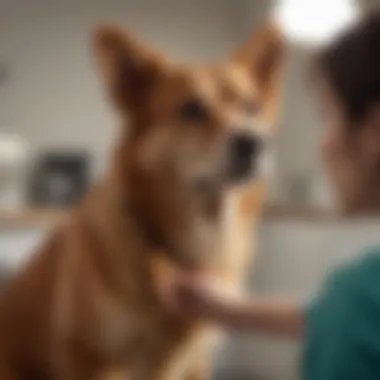Understanding Canine Flatulence: Causes and Solutions


Intro
Canine flatulence is a topic that can elicit varying reactions from pet owners. For some, it’s a source of surprise and maybe even amusement. For others, it raises eyebrows and concerns about their dog's health. Understanding the intricacies of why dogs experience flatulence goes beyond just an olfactory nuisance. It serves as a crucial indicator of not only a dog’s diet but also its overall well-being. Addressing this often-taboo subject with authority and care enhances pet owners’ capability to manage the issue effectively.
Just like humans, dogs can experience gas for a multitude of reasons. Notably, diet emerges as a primary culprit. A dog's food choices directly influence digestive processes, which can lead to the production of gas. However, the implications of excessive flatulence can hint at deeper health matters that require attention.
In this section, we will uncover the possible causes behind canine flatulence, evaluate its implications for a dog’s health, and present practical remedies. Armed with knowledge, dog owners can navigate this unusual yet significant aspect of pet care thoughtfully. Let's dive in to understand our furry friends better and help them lead happier, healthier lives.
Intro to Canine Flatulence
Canine flatulence isn't just a topic for a giggle; it's a serious issue that numerous dog owners face yet might overlook during their furry friends’ daily antics. Understanding this phenomenon goes beyond mere comedic relief—it's crucial for ensuring the overall health and comfort of your pet. This section sets the stage for a thoughtful exploration into the multifaceted nature of dogs and their gaseous emissions.
Significance of Flatulence
Flatulence in dogs can often be a signifier of deeper underlying issues. Ignoring excessive gas can lead to discomfort for the dog, affect their quality of life, and even hint at various health concerns that should not be brushed aside. For pet owners, recognizing the signs that differentiate normal behaviors from excessive production not only aids in maintaining harmony within the home but also ensures that your canine companion remains healthy.
Takeaway for Pet Owners
For many pet owners, canine flatulence is an annoyance at best, a social faux pas at worst. However, unmasking the reasons behind those oddly-timed toots can lead to better dietary choices and health checks that enhance a dog's well-being. Thus, paying heed to this aspect of canine life is tantamount to being a responsible pet owner.
As we progress through this article, we will break down what causes dogs to experience flatulence, delve into what could be considered excess, and discuss practical steps and remedies that can alleviate this condition, creating happier, healthier tails that can wag freely without the added burden of foul odors.
Definition of Flatulence in Dogs
Flatulence in dogs, commonly stuffed into colloquial terms such as dog farts, is the release of gas from the digestive system through the anus. While every living being produces gas, the frequency and odor can tell a different story when it comes to our four-legged companions. This gas can be a natural outcome of the digestion process, typically arising when food breaks down, particularly high in carbohydrates. However, it's essential to draw a line between what’s considered normal pet behavior and what might signal a problem down the road.
Understanding Normal vs. Excessive Gas Production
Not every huff and puff spells trouble. Just as humans might experience gas after a hearty meal, dogs can also pass gas without any underlying issue. Generally speaking, normal flatulence may occur occasionally and often has minimal odor.
In contrast, excessive gas is characterized by frequent occurrences that carry a strong or unpleasant smell. If your dog is passing gas more than usual, or if the odor seems particularly offensive, it could indicate dietary missteps or digestive trouble. Observing your dog's habits and being mindful of their dietary intake will offer insights into whether what you’re dealing with is a typical case or a signal for concern.
"A well-informed dog owner makes for a healthier pet."
In summary, understanding canine flatulence is all about balance: knowing what’s typical versus the unusual. This can set the right course of action and ensure your pup continues to thrive and not just survive.
Common Causes of Dog Flatulence
Understanding the common causes of dog flatulence is essential for pet owners who wish to maintain their dog's gastrointestinal health. Flatulence can arise from various factors, including diet, eating behavior, and underlying health issues. Recognizing these causes can assist in proper management and prevention, allowing for a more comfortable living situation for both the dog and the owner. The implications of excessive gas can range from merely unpleasant odors to signaling potential health concerns that warrant further investigation.
Dietary Influences on Gas Production
Diet plays a significant role in the production of gas in dogs. What a dog eats significantly impacts the magnitude and frequency of gas release. Therefore, paying attention to the ingredients and overall quality of dog food is critical.
Low-Quality Ingredients
Low-quality ingredients in dog food often contribute to increased flatulence. These types of food usually contain fillers or by-products that are hard for dogs to digest. The key characteristic of these ingredients is that they can ferment in the intestines, leading to gas buildup. For a struggling pet owner, low-quality food can appear inexpensive, but this choice may lead to higher vet bills down the road. Their unique feature lies in often being full of artificial additives and preservatives that can upset a dog's digestive system, resulting in gas and bloating.
Dairy Products and Lactose Intolerance
Many dogs are lactose intolerant, leading to flatulence when they consume dairy products. The specific aspect here is that while some dogs may love cheese or milk, their bodies might struggle to process lactose—sugar found in dairy. This results in gas production as the undigested lactose ferments in their gut. The key here is awareness; if a dog frequently experiences gastrointestinal distress after indulging in dairy, eliminating these foods from their diet can often lead to significant improvements. It's a beneficial consideration for this article because it highlights how even seemingly innocent treats could exacerbate the flatulence issue.
High-Fiber Foods
High-fiber foods are generally recognized for their health benefits, but they can also contribute to flatulence when introduced abruptly into a dog's diet. The specific aspect here is the effect of fiber on digestive flora. While fiber aids in digestion, too much or a sudden increase can lead to gas production as the bacteria in the intestines begin to work overtime. The key characteristic of high-fiber foods is their ability to help regulate bowel movement, but pets might experience the unique disadvantage of increased gas if not transitioned properly. It's imperative to introduce fibrous foods gradually to prevent discomfort.


Swallowing Air: The Role of Eating Habits
Eating habits can also lead to increased flatulence in dogs. How a dog eats can directly affect their gas production. Certain habits can promote excessive air swallowing, resulting in bloating and flatulence.
Rapid Eating
Rapid eating is a behavior that can significantly influence a dog's gas production. When dogs eat too fast, they not only consume food but also ingest air. This leads to gastrointestinal discomfort and flatulence. The key characteristic of this issue is the potential health risks it poses, such as bloat, which can be life-threatening. A notable choice for this article is the use of slow feeder bowls, which can encourage dogs to eat more slowly, thus reducing gas production. This unique feature of promoting slower, more mindful eating can ultimately enhance overall digestion and reduce gaseous emissions.
Excitement and Playful Behavior
Excitement or rambunctious behavior during mealtimes can also lead to increased gas production. When a dog is overly excited, they may not only gulp their food but also swallow more air. The key characteristic of this behavior is that it often occurs in social or stimulating environments. Addressing this through controlled feeding settings can provide a more peaceful eating experience, which is a popular choice in enhancing digestion and reducing gas potential. While playfulness is part of a dog's nature, ensuring a calmer atmosphere at mealtime can help mitigate the undesirable side effects like flatulence.
Health Conditions Linked to Flatulence
Unlike dietary issues or eating habits, certain health conditions can also lead to increased flatulence. Acknowledging these can be crucial for understanding your dog's overall health.
Gastrointestinal Disorders
Gastrointestinal disorders can contribute significantly to a dog's flatulence. These include various issues such as inflammatory bowel disease or gastrointestinal parasites. The key characteristic of these disorders is that they disrupt the normal digestive process, leading to gas production. Recognizing symptoms of these conditions is vital. Early intervention can lead to better outcomes, marking it as an important aspect of this article. Understanding these disorders can lead to improved management and dietary adjustments, thus alleviating discomfort.
Food Allergies and Sensitivities
Food allergies and sensitivities are worth noting as they can lead to inflammatory results in the digestive tract, creating gas. The specific aspect here involves immune responses to certain proteins found in foods. Dogs suffering from these allergies may display symptoms ranging from skin issues to digestive disturbances, including flatulence. Awareness of these sensitivities is beneficial for owners seeking a tailored diet for their pets. The unique feature lies in the need for specialized feeding regimens that eliminate irritants, thereby enhancing overall gut health.
Underlying Diseases
Underlying diseases can also manifest as increased flatulence in dogs. This can include metabolic disorders or other chronic illnesses. The key characteristic of these diseases is that they can create imbalances in digestion or disrupt normal gut flora. For pet owners, identifying these signs and seeking veterinary consultation is critical for proper diagnosis and treatment plans. The unique feature of recognizing these diseases is that they highlight the need for a comprehensive approach to a dog's dining habits, making it vital for overall wellness.
Evaluating Your Dog's Gas Production
Understanding how to evaluate your dog's gas production is essential for pet owners who wish to maintain their pets' health and comfort. Dogs, like people, can experience various levels of digestive discomfort. However, knowing when gas becomes a problem is a crucial part of responsible pet ownership.
Monitoring gas production in your dog allows you to assess whether their flatulence is within normal limits or if professional guidance is needed. It involves observing certain key parameters like frequency, smell, and any accompanying behaviors. By doing so, you can provide your veterinarian with precise information that could simplify diagnosis and treatment should issues arise. It’s about becoming an advocate for your furry friend.
Frequency and Smell: What is Considered Excessive?
The frequency and distinct odor of your dog's gas are two fundamental indicators you should pay close attention to. Normal gas production is something all dogs experience, and it’s rarely a cause for concern. However, if you notice your dog passing gas excessively, it's worth taking a deeper dive.
Generally, if the flatulence occurs more than once or twice a day, or the smell is offensive enough to make you wrinkle your nose, it could signify an underlying issue. In such cases, tracking these episodes accurately can help you determine whether it’s just a dietary indiscretion or something more serious requiring veterinary attention.
Monitoring Changes in Behavior and Health
Signs of Discomfort or Distress
When evaluating your dog's gas production, it's equally critical to monitor any signs of discomfort or distress. If your dog appears to be unusually restless, whining, or showing signs of pain, these could indicate that flatulence is more than just a benign bodily function.
Dogs often communicate their discomfort indirectly through behavior. For example, if your dog is frequently licking their lips, avoiding interaction, or glaring at their belly, it may signal digestive issues. Being attuned to these behavioral changes can offer vital clues about your pet's overall health and emotional state. Ignoring these signals may lead to overlooked medical conditions.
Changes in Appetite or Weight
Changes in appetite or weight can also serve as essential indicators of your dog's health. If your dog suddenly loses interest in their food or is overeating, this inconsistency could be linked to digestive problems, including excessive gas.


Keep an eye out for moderate shifts in weight as well. An unexpected weight gain could point toward overeating due to discomfort with food choices, or weight loss may suggest an inability to absorb nutrients properly. These variations often go hand in hand with gastrointestinal distress, including flatulence.
It's crucial to establish a baseline for your dog's normal behavior and eating habits to make these evaluations easier. If you notice noticeable shifts, consider consulting a veterinarian who can provide tailored recommendations based on your dog's individual needs.
"Regular observation of your dog's behavior, along with monitoring flatulence, allows you to maintain not just their comfort but also their overall health."
Strategies for Managing Canine Flatulence
Managing canine flatulence can be a tricky endeavor. While it's essential to understand that some gas is normal for dogs, addressing excessive flatulence is critical for both the health of the dog and the comfort of everyone around them. This section covers practical strategies that can significantly reduce the issue and improve quality of life.
Adjusting Dietary Habits
Choosing High-Quality Dog Food
One of the most effective ways to manage canine flatulence is to start with the basics: the dog's diet. Choosing high-quality dog food is often linked to better digestion. Typically, high-quality brands use premium ingredients which are easier for dogs to break down. The key characteristic of these foods is their formulation; they often contain real meats, whole grains, and fewer fillers. This means less gas is produced during the digestion process.
Moreover, many high-quality dog foods come with added probiotics, which are good for the gut. This unique feature not only aids in digestion but can also lead to healthier stools and less odor. In this article, it’s emphasized that selecting a reputable brand can make a noticeable difference in your dog’s flatulence.
Avoiding Human Food Scraps
Many pet owners are tempted to share their meals with their furry companions. However, avoiding human food scraps is a smart move for combating flatulence. The really pivotal aspect here is that human food, especially processed or rich in fat, may not align with a dog’s digestive system. The key characteristic of this approach is that it discourages foods that could irritate the gastrointestinal tract or lead to discomfort.
The unique feature of human food scraps is their unpredictability; they can lead to an upset stomach or worse if the dog has allergies or sensitivities. In this article, it's noted that sticking to dog-specific food can help mitigate gas issues and maintain a balanced diet for your pet.
Encouraging Slower Eating
Using Slow Feeders
Using slow feeders is another effective strategy to manage gas in dogs. Often, dogs gulp their food too quickly, swallowing air along with it. A slow feeder can help counteract this problem. The key characteristic of slow feeders is their design, which typically features obstacles or grooves that prevent fast eating. This encourages dogs to take their time, which reduces the amount of air ingested.
A unique feature of many of these bowls is that they are often fun and engaging for dogs. This can turn mealtime into an enriching experience rather than a race. The advantages of using slow feeders in this article highlight how they not only reduce gas but also contribute to better digestion overall.
Implementing Meal Time Routines
Establishing a consistent feeding schedule can also play a vital role in reducing flatulence. Implementing meal time routines helps regulate a dog's digestive system. Dogs thrive on routine, and predictable feeding times can lead to better digestion.
The key characteristic of this approach is its simplicity. By feeding your dog at the same time every day, you may notice a reduction in gas production. This article points out that familiar routines can prevent overeating or scavenging habits that can lead to gas. Alongside, behavior changes may also occur, signifying a positive impact on the dog’s health and well-being.
Consulting with a Veterinarian
Diagnostic Tests for Underlying Issues
When all else fails, it's time to reach out to a professional. Diagnostic tests for underlying issues can reveal health problems that might contribute to excessive flatulence. The key characteristic of these tests, whether a simple stool analysis or more comprehensive blood work, is their ability to pinpoint gastrointestinal disorders or allergies.
The unique feature of having a veterinarian involved is that they can tailor recommendations specifically for your dog. They might discover issues that are easily overlooked by pet owners. This article emphasizes that understanding the root cause is vital for effective management.
Professional Dietary Recommendations
Once you involve a veterinarian, they can also offer professional dietary recommendations tailored to your dog's unique needs. This characteristic ensures that the diet change recommended is scientifically backed and suitable for your pet's health status.
The unique feature of these recommendations is their personalized nature. While general advice is useful, every dog is different, and the professional insight takes into account factors like age, weight, and health issues. In this article, it's stressed that a tailored approach often leads to the most significant improvements in gas-related concerns.


Natural Remedies for Reducing Flatulence
Canine flatulence can be uncomfortable not just for the dog but also for their human companions. When tackling this issue, many people are on the lookout for natural remedies that can help alleviate the situation. Natural remedies can offer holistic benefits and provide gentle solutions without the side effects of synthetic medications. They often focus on improving digestion and addressing underlying dietary issues, which can significantly impact a dog's overall health.
Probiotics and Digestive Aids
One effective approach to reduce gas production in dogs is through probiotics and digestive aids. Probiotics are live bacteria that, when consumed, can enhance gut health by restoring the balance of microorganisms in the intestine. Dogs suffering from digestive disturbances may find relief by introducing these into their diets.
For instance, adding yogurt or kefir into a dog’s meal can help introduce beneficial bacteria. However, it's crucial to ensure that these products are plain, without any artificial sweeteners like xylitol, which is toxic for dogs.
Moreover, digestive aids can taken the form of supplements or certain foods rich in enzymes that help break down food more effectively. The richness of these ingredients assists in making your dog’s digestive tract work smoothly, thus reducing gas.
Homemade Dietary Adjustments
Adjusting your dog's diet at home can work wonders for gas too. Making thoughtful changes can bring noticeable improvements.
Introducing Digestive-Friendly Foods
One specific way to mend the situation is by introducing digestive-friendly foods. Foods like pumpkin, sweet potatoes, and even plain green beans can be excellent additions. They not only are gentle on the tummy but also promote better digestion.
The key characteristic of these foods lies in their fiber content that is easily digestible. Incorporating them into a dog's diet can lead to a more balanced gut flora and help minimize gas production.
However, while these foods are beneficial, introducing them has to be done gradually. Such foods may also bring fiber overload if added too quickly, leading to bloating instead of relief.
Hydration and Its Importance
Another aspect that frequently flies under the radar is hydration. Keeping your dog well-hydrated is essential for overall digestive health. Water assists in breaking down food in the intestines and aids in nutrient absorption. When a dog is well-hydrated, the digestive system functions more efficiently, which can reduce excess gas.
The unique feature of ensuring ample hydration is its simplicity. Just ensure your dog has access to fresh, clean water at all times. Dehydration can lead to constipation and other digestive problems that could worsen flatulence. A simple fix like increasing water intake can serve dual purposes of aiding digestion and improving health.
"A well-hydrated dog is a healthier dog. Don't overlook the basics!"
In summary, natural remedies can deliver profound benefits when it comes to reducing canine flatulence. From probiotics enhancing gut health to homemade dietary adjustments that prioritize specific foods and hydration, these approaches are typically safe and beneficial for dogs. These strategies not only tackle the issue of gas but also promote overall well-being in our furry friends.
Culmination: Embracing Your Dog's Unique Nature
Understanding our furry companions goes beyond basic care; it involves appreciating their individual traits and behaviors. Just like humans, dogs possess unique personalities and physiological characteristics. This diversity often extends to how and why they experience flatulence. Recognizing that there isn’t a one-size-fits-all solution can foster a more compassionate attitude toward managing canine flatulence. This article dives deep into the multifaceted aspects of dog gas production, but fundamentally, the takeaway is about celebrating these differences.
Recognizing Natural Variability in Dogs
Every dog is different, shaped by their breed, age, and overall health. A Great Dane may produce gas in quantities far exceed that of a Pomeranian. Certain breeds, like Bulldogs or Boxers, are predisposed to more flatulence due to their anatomy and eating habits. Factors like diet also play a significant part—what works for one dog might cause another to develop digestive upset.
Being mindful of these variations means that each dog owner should tailor their approach, mixing trial and error with a deep understanding of their dog's specific needs. For instance, if your dog has an irritable stomach after meals, switching to a sensitive stomach formula might work wonders.
This emphasis on recognizing the natural variability in dogs lays a foundational understanding. With knowledge, it enhances relationships between pet owners and their companions. After all, embracing these quirks, and adjusting accordingly, improves overall care and reinforces the bond shared with our pets.
The Importance of Ongoing Care and Observation
Caring for a dog isn't simply a one-off task, it's an ongoing commitment. Regular monitoring of your dog's digestive health plays a crucial role in preventative care. Look out for subtle changes. A sudden increase in flatulence or alterations in eating patterns may signal underlying health issues or sudden dietary intolerance.
Ongoing care involves consulting with a veterinarian to discuss any concerns about gas production and addressing dietary choices regularly. Keeping an eye on your dog’s behavior and physical condition can help catch potential problems before they escalate.
Consider maintaining a health journal. You can document meal types, gas frequency, and behavior changes. This information can be invaluable during vet visits as it provides a clearer picture of your dog’s well-being and can lead to more effective treatment plans.
"A proactive approach to your dog's health can prevent minor issues from bubbling over into major problems."
In summary, embracing the uniqueness of each dog requires not just understanding their natural behaviors but also committing to their long-term health through vigilance and tailored care. With this attitude, pet owners can navigate the sometimes stinky, yet entirely normal, world of canine flatulence with both patience and expertise.







